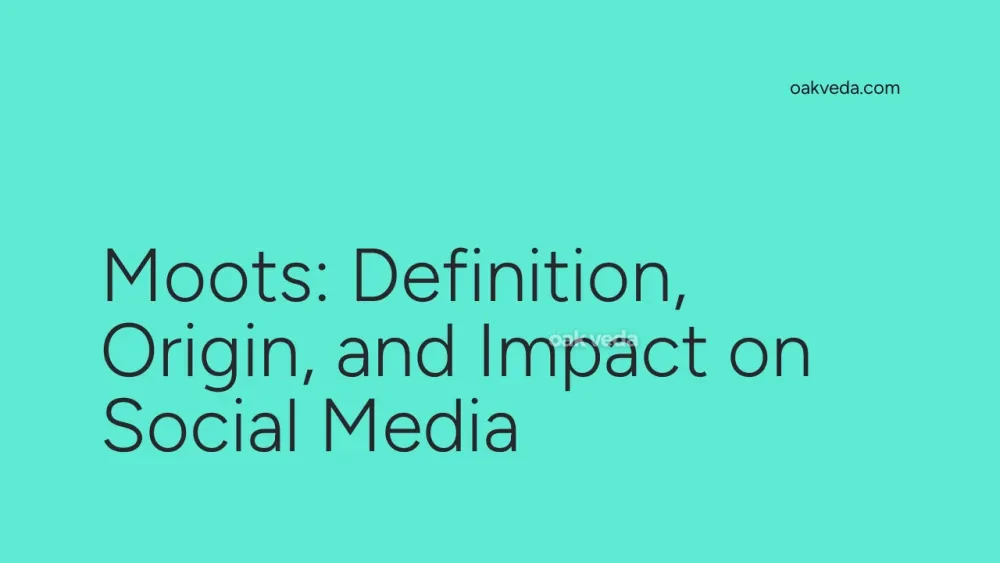
What are Moots?
In the ever-evolving landscape of social media, new terms and slang constantly emerge. One such term that has gained popularity is "moots." Short for "mutuals" or "mutual followers," moots refers to users who follow each other on social media platforms, particularly on Twitter and Tumblr. This reciprocal relationship creates a sense of shared online camaraderie and community.
Origin and Development of Moots
The term "moots" originated as internet slang, likely emerging in the early 2010s as social media platforms gained widespread popularity. It's a shortened version of "mutuals," which itself is an abbreviation of "mutual followers." The exact origin is difficult to pinpoint, but its usage became more prevalent on Twitter and Tumblr before spreading to other platforms.
How Moots Works
The concept of moots is simple yet significant in the social media ecosystem:
- User A follows User B
- User B follows User A back
- Both users are now considered each other's "moots"
This mutual following creates a two-way connection, allowing both users to see each other's content in their feeds and interact more frequently.
Types or Variations of Moots
While the basic concept of moots remains consistent, users have developed variations to describe different levels of mutual relationships:
- Close moots: Mutuals who interact frequently and have a stronger online friendship
- Mutual moots: A redundant but commonly used term emphasizing the reciprocal nature of the relationship
- New moots: Recently established mutual connections
Popular Examples of Moots
Moots are particularly prevalent on Twitter and Tumblr, where users often:
- Use the term in tweets or posts, e.g., "Good morning, moots!"
- Create "moot threads" to help users find new people to follow
- Organize "moot swaps" where users agree to follow each other
Impact of Moots on Social Media Culture
The concept of moots has significantly influenced social media culture in several ways:
- Community Building: Moots foster a sense of belonging and create micro-communities within larger platforms.
- Content Curation: Users are more likely to see content from their moots, creating personalized feeds.
- Engagement Boost: Mutual followers tend to interact more frequently, increasing overall platform engagement.
- Support Networks: Moots often provide emotional support and validation to each other online.
How Brands and Influencers Use Moots
Savvy brands and influencers have recognized the power of moots in their social media strategies:
- Influencer Collaborations: Influencers often become moots with each other to cross-promote content.
- Brand Engagement: Some brands follow back their followers to create a sense of connection and loyalty.
- Community Management: Social media managers use the concept of moots to foster a more engaged follower base.
Future Trends Related to Moots
As social media continues to evolve, we can expect the concept of moots to adapt and expand:
- AI-Powered Moot Suggestions: Platforms may develop algorithms to suggest potential moots based on interests and interactions.
- Cross-Platform Moots: As users diversify their social media presence, the concept of moots may extend across multiple platforms.
- Moot-Centric Features: Social media platforms might introduce features specifically designed for interacting with moots, such as prioritized notifications or exclusive sharing options.
FAQs about Moots
What's the difference between a follower and a moot?
A follower is someone who subscribes to your content, while a moot is a mutual follower – someone you follow who also follows you back.
Can brands have moots?
Yes, brands can have moots if they follow users back, creating a mutual connection.
Is the term "moots" used on all social media platforms?
While the concept exists across platforms, the term "moots" is most commonly used on Twitter and Tumblr.
How can I increase my moots?
To increase your moots, actively engage with your followers, create interesting content, and participate in moot threads or follow trains.
Are moots more valuable than regular followers?
Moots often lead to higher engagement and stronger online relationships, making them potentially more valuable for meaningful interactions.
Conclusion
The concept of "moots" has become an integral part of social media culture, particularly on platforms like Twitter and Tumblr. It represents a shift towards more reciprocal, community-focused online interactions. As social media continues to evolve, the importance of moots in shaping digital communities and influencing user behavior is likely to grow. Understanding and leveraging this concept can be valuable for individuals, brands, and influencers looking to build stronger, more engaged online networks.
You may be interested in:
- Menty B: Definition, Origin, and Impact on Social Media
- Unfollow: Definition, Origin, and Impact on Social Media
- Demographics in Social Media: Definition, Origin, and Impact
- B2B in Social Media: Definition, Origin, and Impact
- Situationship: Definition, Origin, and Impact
- Banger: Definition, Origin, and Impact in Social Media

